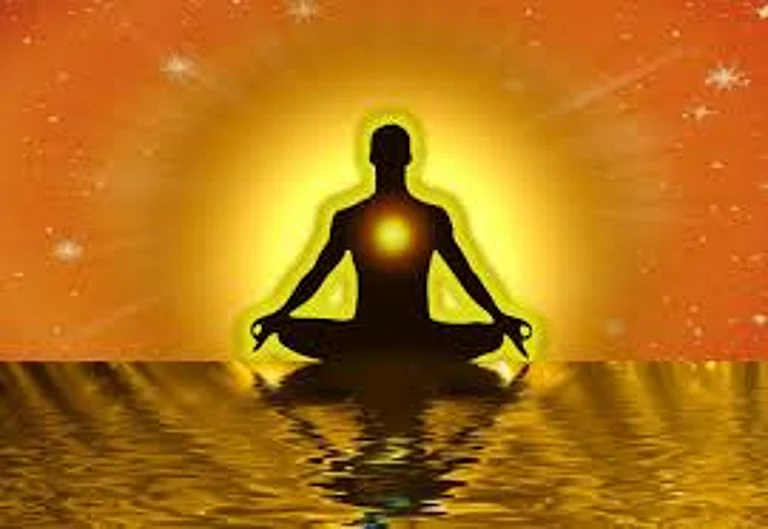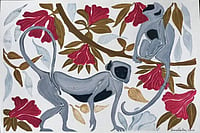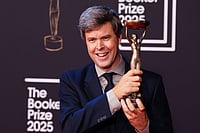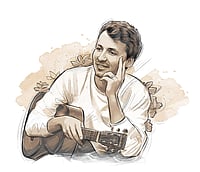Trigger Warning: This story contains mentions of suicide. Reader discretion is advised. If you or someone you know is struggling, please contact these numbers. Helpline: iCall (9152987821) or AASRA (+91-22-27546669)— Available 24/7

Link between creativity and madness has mystified us from time immemorial.
Ancient Greeks considered 'blessed madness' a gift from the Muses themselves.
Sanity and insanity have been judged and defined variously across the ages.
Sylvia Plath, one of the most admired poets of the twentieth century, wrote in her journal: "I look down into the warm, earthy world...and feel apart, enclosed in a wall of glass." Plath was diagnosed with depression at 20 after a failed suicide attempt. She suffered from mood swings. Her adult life was spent see-sawing between intense spurts of creative activity and phases when she was unable to take on the simplest everyday tasks. In Sandhya Mary’s novel ‘Maria, Just Maria’ (trans. Jayasree Kalathil; 2024), the young heroine, Maria, is admitted to a mental asylum. She doesn’t fit into the ‘normal/abnormal’ binary. Defiant in the face of the world’s so-called sanity, she tells her mother, “Truly, Ammachi, I don’t understand your world or its standards!” Maria feels that when people adapt to a state being that is most suited to who they are, we like to call them mad. According to Maria’s creator, Sandhya Mary, creativity and madness can be like twins at times. “In the case of both, your brain is playing or you are playing with your brain,” she says. “Sometimes creativity becomes so intense and you feel that you might fall into madness.”
Ancient Greeks called this intense state—‘theia mania’ (divine madness)—a gift from the gods. In Plato’s ‘Phadreus’, four types of divine madness find a mention: poetic, prophetic, initiatory and erotic. Poetic madness was considered a blessing from the Muses. Unlike madness caused by biochemical imbalances in the body, divine madness was seen as a source of inspiration, from which great works of art could be forged. Those touched by divine madness were free to experience life in a different way; to be open to epiphany, to be transformed by wonder and awe. Shattering the shackles of logical understanding, they could cross over to other realms of consciousness, see an all too familiar world with fresh eyes. “The madness that is a ‘gift of the gods’ seizes a person by the hair and propels them beyond their usual mental space,” says Israeli poet and novelist Amir Or, who recently translated the ‘Bhagavad Gita’ into Hebrew. Or sees blessed madness as a freeing force, a state that “generates new vessels for mental experience with unusual speed and flexibility”.
Emily Dickinson realised that “much madness is divinest sense.” Dorothy Parker, whose acerbic wit and acid tongue had no equal in literary circles, described creativity as a “wild mind” with a disciplined eye. Cervantes warned us that too much sanity may be, in fact, madness. Kazantzakis wisely prescribed: “A person needs a little madness, or else they never dare cut the rope and be free.” But when has cutting the rope and finding freedom ever been a socially sanctioned pursuit? Hence, madness incurred its share of disapproval.
“Sanity and insanity are categories that have been judged and defined variously across the ages,” says Kashmiri poet and academic Huzaifa Pandit. He talks of pre-colonial times when madness was seen as a conduit with a metaphysical realm. “The Urdu ghazal, for example, provides enough evidence of this where ‘aashufta-sari’—madness—is celebrated as a hallmark of an emotive richness,” Pandit says. “Artists possess some degree of heightened sensitivity to create art. Everyone is capable of feeling emotions or receiving perceptions. Yet, only artists feel the urge to create out of the perceptive matrix.”
Finding the Words
Many a creative mind has struggled with mental illnesses. Many have written about their experiences, sharing their extremely personal journeys with readers. Some write to codify memories, to find clarity in the chaos. Others seek solace in cathartic release. Shreevatsa Nevatia, journalist and author of ‘How to Travel Light: My Memories of Madness and Melancholia’, realised he had done something “intimate and irreversible” after his memoir was published. “I had placed my mind on the page for strangers to examine,” says Nevatia, whose intent wasn't to shock readers, but to honestly tell his truth. Though some readers found parts of it—particularly the portions on psychiatric institutionalisation and abuse—difficult to get through, others called it brave, and were deeply moved by it. “Readers with their own histories of mental illness wrote to say they saw themselves reflected in the pages,” Nevatia remembers. “Some said the book made them feel less alone, which meant more to me than any review.”
Virginia Woolf, who suffered from severe depression and bipolar disorder, penned some of the most intense accounts of mental illness. Kafka was clinically depressed for most of his life (and had no faith in therapy). “I have the true feeling of myself only when I am unbearably unhappy,” he once said. Anxiety and feelings of alienation haunt his fiction and his diaries. Plath laid bare her inner darkness in raw verse. She died by suicide at the age of 30. Prolific Malayalam writer Vaikom Muhammad Basheer was admitted to sanitoriums twice. ‘Pathummayude Adu’ (Pathumma's Goat), one of his most memorable novels, was written while he was undergoing treatment at a mental hospital in Thrissur, Kerala. Author and playwright Swadesh Deepak’s memoir, ‘Maine Mandu Nahi Dekha’ (I Have Not Seen Mandu), is a vivid, experiential account of his illness. Diagnosed as bipolar in the 1990s, the Sangeet Natak Akademi Award winner stepped out of his home for a walk on June 7, 2006, and has been missing since.
Deepak’s hallucinatory memoir of madness, David Foster Wallace’s introspective accounts of his therapy sessions and his use of antidepressants, Jerry Pinto’s novel ‘Em and the Big Hoom’, which draws from his lived experience of his mother’s mental illness, Anne Sexton’s bruised confessional poetry, which she began to write while wading through postpartum depression, Plath’s poems, Hemingway’s musings on his mental health issues—all of it gives readers a chance to walk the paths they walked, to shed judgement, to empathise. Their works remind us that different cultures view madness differently. That sanity and insanity are not absolutes. “In the ‘sane’, there is something mad; conversely, within the ‘mad’, there is an element of sanity,” Or notes.
And that begs the question: who sets the norms of sanity and insanity? History is littered with instances of people being branded ‘mad’ when they threaten the existing hierarchy. ‘Madness’ becomes a ruse to silence dissent, to nurture conformity. When Galileo revealed that the Earth is the centre of the solar system, and not the Sun, both the scientific community and the Catholic Church called him crazy. When women first demanded the right to vote, suffragettes were written off as deranged and hysterical, and chained to roadside pillars and posts. “Any time people—they could be creative, with brilliant minds—deviate from society’s norms even slightly, how easily they are branded crazy!” says Mary. Pandit agrees, adding that since art has the potential to upend normativity and expose the contradictions of foundational values like patriotism and purity, the label of madness is used to tame art's subversive potential.
Nevatia’s views on sanity and insanity have been shaped by personal experience. “Having lived with a bipolar diagnosis for 18 years—and having weathered nearly a dozen cycles of mania and depression—I now prize my sanity as a kind of home,” he says. “It’s not about fitting in. It is about feeling at peace in my own head.”
The Myth of the Mad Genius
More than a few stars who burnt bright on the firmament of art, literature and science have had a history of mental illness. We’ve heard their stories. Been privy to their highs and lows. But there is wisdom in steering clear of generalisation. Popular culture perpetuates the myth of the “mad genius”, leaving no room for nuance. The urge to equate creative brilliance with madness is not rooted in logic. Neither is it scientifically sound. A study by American neuroscientist Nancy Andreasen, published in 1987, found a high incidence of bipolar disorder among creative writers and their family members. A different study published two years later, focusing on British artists and writers, found a 38 per cent incidence of mood disorder. Both studies were criticised for their limited sample size. Judith Schlesinger, psychologist and author of ‘The Insanity Hoax: Exposing the Myth of the Mad Genius’, argues that the mad genius hypothesis lacks scientific credibility and pathologises creators, neglecting their talent and hard work.
“Writers are very much part of the world,” says author and theatre practitioner Naveen Kishore, who acknowledges that the act of writing as a solitary pursuit... "Of digging into memory. Of waiting for language to find an opportune moment and reveal itself.” In the moment of creation, artists may forget everything around them. This could be interpreted as madness in a sense. However, Kishore refutes the perception that artists are always on edge. But is it possible to be totally in tune with the world and be a creative person? Pandit doesn't rule out the possibility of survival. Yes, one can build "a life that doesn’t transgress so far as to invite exclusion and censure." But he doubts if any artist can surrender fully to the "world's dull routine, or be completely at peace with it, even if one appears to outwardly comply with it."






























